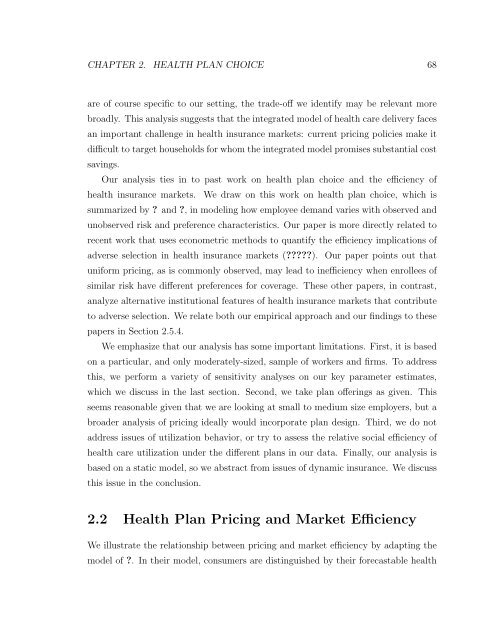essays in public finance and industrial organization a dissertation ...
essays in public finance and industrial organization a dissertation ...
essays in public finance and industrial organization a dissertation ...
Create successful ePaper yourself
Turn your PDF publications into a flip-book with our unique Google optimized e-Paper software.
CHAPTER 2. HEALTH PLAN CHOICE 68<br />
are of course specific to our sett<strong>in</strong>g, the trade-off we identify may be relevant more<br />
broadly. This analysis suggests that the <strong>in</strong>tegrated model of health care delivery faces<br />
an important challenge <strong>in</strong> health <strong>in</strong>surance markets: current pric<strong>in</strong>g policies make it<br />
difficult to target households for whom the <strong>in</strong>tegrated model promises substantial cost<br />
sav<strong>in</strong>gs.<br />
Our analysis ties <strong>in</strong> to past work on health plan choice <strong>and</strong> the efficiency of<br />
health <strong>in</strong>surance markets. We draw on this work on health plan choice, which is<br />
summarized by ? <strong>and</strong> ?, <strong>in</strong> model<strong>in</strong>g how employee dem<strong>and</strong> varies with observed <strong>and</strong><br />
unobserved risk <strong>and</strong> preference characteristics. Our paper is more directly related to<br />
recent work that uses econometric methods to quantify the efficiency implications of<br />
adverse selection <strong>in</strong> health <strong>in</strong>surance markets (?????). Our paper po<strong>in</strong>ts out that<br />
uniform pric<strong>in</strong>g, as is commonly observed, may lead to <strong>in</strong>efficiency when enrollees of<br />
similar risk have different preferences for coverage. These other papers, <strong>in</strong> contrast,<br />
analyze alternative <strong>in</strong>stitutional features of health <strong>in</strong>surance markets that contribute<br />
to adverse selection. We relate both our empirical approach <strong>and</strong> our f<strong>in</strong>d<strong>in</strong>gs to these<br />
papers <strong>in</strong> Section 2.5.4.<br />
We emphasize that our analysis has some important limitations. First, it is based<br />
on a particular, <strong>and</strong> only moderately-sized, sample of workers <strong>and</strong> firms. To address<br />
this, we perform a variety of sensitivity analyses on our key parameter estimates,<br />
which we discuss <strong>in</strong> the last section. Second, we take plan offer<strong>in</strong>gs as given. This<br />
seems reasonable given that we are look<strong>in</strong>g at small to medium size employers, but a<br />
broader analysis of pric<strong>in</strong>g ideally would <strong>in</strong>corporate plan design. Third, we do not<br />
address issues of utilization behavior, or try to assess the relative social efficiency of<br />
health care utilization under the different plans <strong>in</strong> our data. F<strong>in</strong>ally, our analysis is<br />
based on a static model, so we abstract from issues of dynamic <strong>in</strong>surance. We discuss<br />
this issue <strong>in</strong> the conclusion.<br />
2.2 Health Plan Pric<strong>in</strong>g <strong>and</strong> Market Efficiency<br />
We illustrate the relationship between pric<strong>in</strong>g <strong>and</strong> market efficiency by adapt<strong>in</strong>g the<br />
model of ?. In their model, consumers are dist<strong>in</strong>guished by their forecastable health










